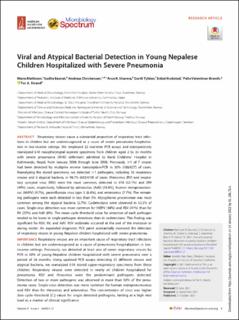| dc.description.abstract | Respiratory viruses cause a substantial proportion of respiratory tract infections in children but are underrecognized as a cause of severe pneumonia hospitalization in low-income settings. We employed 22 real-time PCR assays and retrospectively reanalyzed 610 nasopharyngeal aspirate specimens from children aged 2 to 35 months with severe pneumonia (WHO definition) admitted to Kanti Childrens’ Hospital in Kathmandu, Nepal, from January 2006 through June 2008. Previously, ≥1 of 7 viruses had been detected by multiplex reverse transcription-PCR in 30% (188/627) of cases. Reanalyzing the stored specimens, we detected ≥1 pathogens, including 18 respiratory viruses and 3 atypical bacteria, in 98.7% (602/610) of cases. Rhinovirus (RV) and respiratory syncytial virus (RSV) were the most common, detected in 318 (52.1%) and 299 (49%) cases, respectively, followed by adenovirus (AdV) (10.6%), human metapneumovirus (hMPV) (9.7%), parainfluenza virus type 3 (8.4%), and enterovirus (7.7%). The remaining pathogens were each detected in less than 5%. Mycoplasma pneumoniae was most common among the atypical bacteria (3.7%). Codetections were observed in 53.3% of cases. Single-virus detection was more common for hMPV (46%) and RSV (41%) than for RV (22%) and AdV (6%). The mean cycle threshold value for detection of each pathogen tended to be lower in single-pathogen detections than in codetections. This finding was significant for RSV, RV, and AdV. RSV outbreaks occurred at the end of the monsoon or during winter. An expanded diagnostic PCR panel substantially increased the detection of respiratory viruses in young Nepalese children hospitalized with severe pneumonia. IMPORTANCE Respiratory viruses are an important cause of respiratory tract infections in children but are underrecognized as a cause of pneumonia hospitalization in low-income settings. Previously, we detected at least one of seven respiratory viruses by PCR in 30% of young Nepalese children hospitalized with severe pneumonia over a period of 36 months. Using updated PCR assays detecting 21 different viruses and atypical bacteria, we reanalyzed 610 stored upper-respiratory specimens from these children. Respiratory viruses were detected in nearly all children hospitalized for pneumonia. RSV and rhinovirus were the predominant pathogens detected. Detection of two or more pathogens was observed in more than 50% of the pneumonia cases. Single-virus detection was more common for human metapneumovirus and RSV than for rhinovirus and adenovirus. The concentration of virus was higher (low cycle threshold [CT] value) for single detected pathogens, hinting at a high viral load as a marker of clinical significance. | |
